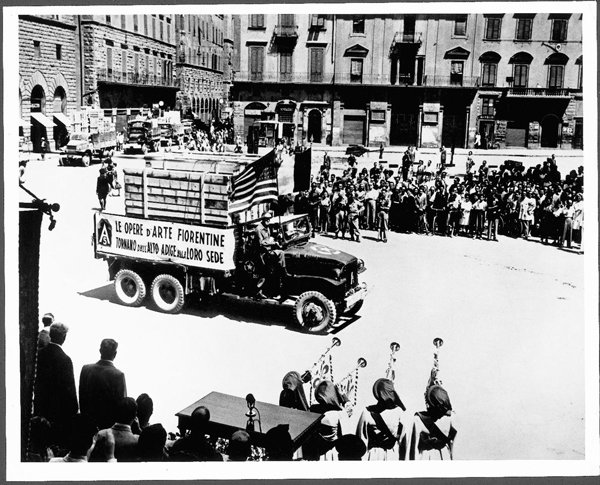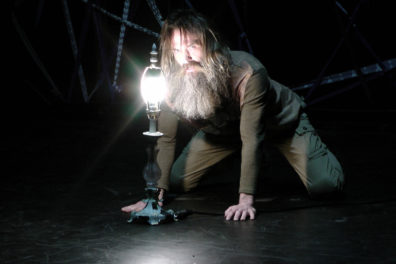
Robert Edsel
Telling the story of Allied efforts to save art in Europe during World War II is Robert Edsel’s life’s work. His focus now is the adventures of the “Monuments Men,” professors and scholars who raced to discover the location of billions of dollars of missing artwork taken from the great museums in Florence and Naples. On June 2, Edsel will be at the Getty Center to talk about his new book Saving Italy: The Race to Rescue a Nation’s Treasures from the Nazis, which is part history, part rip-roaring drama.
I asked Robert about the Monuments Men and how their efforts saved treasured art from across Europe.
What makes the story of the Monuments Men so intriguing?
Because it seems difficult to believe that such an epic story about World War II could have been hidden right in front of us, 68 years after the end of the most destructive war in history! Few people know the story of how this small group of ordinary men and women—museum professionals, educators, architects, and artists—saved so much of the art and culture of western civilization from the destruction of war, and then served as art detectives in locating and saving millions of objects stolen by the Nazis.
Why do you think their story is not better known?
The Monuments Men, like other members of the Greatest Generation, didn’t discuss what they did after the war; too many soldiers died for anyone to be singing their own praises. Also, while the end of the war saw millions of soldiers return home, the work of the monuments officers was just beginning. The discovery of thousands of caves, castles, and mines containing tens of thousands of priceless art masterpieces meant years of sorting to determine ownership and effect returns.
By the time the last Monuments Men returned home in 1951, they had overseen the return of more than five million items to the countries from which these objects had been looted. Additionally, a new war was underway: the Cold War, and soon Korea. Their remarkable legacy was lost in the fog of war.

The triumphant return of the Florentine treasures took place on July 22, 1945. This truck passed before the review stand under the Loggia di Lanza, then stopped in front of the Palazzo Vecchio where, seven years earlier, thousands of Florentines had greeted the arrival of German leader Adolf Hitler. Courtesy of National Archives and Records Administration, College Park, MD
What is it about the theft and recovery of fine art that makes for a compelling narrative?
I don’t think it has as much to do with the theft of art as it does with human interest.
What makes a man risk his life to save someone else’s life, much less a work of art? Why does a middle-aged scholar who has life made, with an established career and happy family, volunteer for military service knowing he might lose his life? Why would an American want to save a work of art belonging to a country not his own? How could a Nazi SS officer involved in sending innocent people to concentration camps at the same time have the sensitivity to help save priceless artistic masterpieces?
It’s stories like these that captivate the reading public. We all want to know what makes people do the things they do, especially when their actions appear counterintuitive. War creates a ripe environment for these extremes.

Monuments Officer Captain Deane Keller visits the Florentine repository at Montegufoni during the winter of 1944/45. The 246 paintings found by Fred Hartt in early August 1944, including Botticelli’s masterpiece Primavera, were still there. Deane Keller Papers. Manuscripts & Archives, Yale University
How many masterpieces do you estimate were lost or destroyed during World War II?
Hundreds of thousands of works of art and documents remain missing from the World War II period. The Monuments Men Foundation has played an important role in helping identify priceless and important documents taken by soldiers as souvenirs unaware of their historical importance.
Your book The Monuments Men is being made into a movie. What are your hopes for the film adaptation?
George Clooney and Grant Heslov have worked very hard to produce an incredible film that will stir the emotions and imaginations. Their world-class cast, including Matt Damon, Bill Murray, Hugh Bonneville, John Goodman, Jean Dujardin, Bob Balaban, and others, will bring to life this amazing and unknown story that will answer the question that first aroused my curiosity in 1997: how did so many of the world’s most beloved artistic masterpieces survive the most destructive war in history, and who were the people that saved them?
The film will also remind us of a time when America established the gold standard for the protection of cultural treasures, something we sadly forgot as demonstrated by the events that followed the 2003 invasion of Iraq and the subsequent looting and destruction of that country’s most important museums, libraries, and archives. I believe this film will press the reset button.
Text of this post © J. Paul Getty Trust. All rights reserved.




Comments on this post are now closed.